A Quad-Band Shared-Aperture Antenna Based on Dual-Mode Composite Quarter-Mode SIW Cavity for 5G and 6G with MIMO Capability
Abstract
:1. Introduction
- It is a multi-band, multi-application antenna that is integrated into a single-layer PCB with a quite small overall footprint area of only 6 × 10 mm2 (0.1λ0 × 0.18λ0), where λ0 represents the free space wavelength at 5.5 GHz.
- For the first time, three distinct resonances with a high frequency ratio of approximately 23 are generated from a shared-aperture antenna that comprises integrated SIW sub-cavities. Furthermore, these sub-mode cavity antennas are used with the dual-mode composite to form sub-6 GHz Mw band antennas. This results in a very high reuse aperture utilization (RAU) efficiency of about 92%.
2. The Proposed Design Configuration
3. Evolution Process and Parametric Study
3.1. Evolution Process
3.2. Surface Current Distributions
3.3. Parametric Study
4. Simulated and Measured Results
4.1. Scattering Parmeters
4.2. Total Radiation Effciency and Gain
4.3. Far-Field Radiation Patterns
4.4. MIMO Performance Parameters
5. State-of-the-Art Comparison
- The proposed antenna is designed based on a new hybrid design technique; it is based on a dual-mode composite antenna and higher-order modes of sub-mode-SIW-cavities for the first time. This is different from current techniques of shared-aperture antennas in the open literature, which are designed based on the dual-mode composite and higher-order modes of full-mode cavity antennas [30,31,32,33,34,35], while self-multiplexing antennas are based on sub-mode cavity antennas alone, without the dual-mode concept [20,21,22,23,24,25,26,27,28,29].
- In terms of frequency ratio, most current design techniques have low frequency ratios, as they are only able to operate in a few close frequencies in either Mw [25,26,31,32,34] or MMw [21,24,30,33], or both [37,38,40]. The proposed design has a high frequency ratio (about 23), as it operates in Mw, MMw, and sub-THz frequency applications. Although the proposed design in [37] has a higher frequency ratio than this work, the current work has a very small footprint area () compared to [37].
- Regarding the electrical size, and for fair comparison with reported works, the calculation of footprint area was made at the longest wavelength of each reported work. Consequently, the proposed antenna has the lowest footprint area compared to all previous works in the table. The footprint area is calculated based on the electrical lengths; it is about 0.018, where λ0 represents the free space wavelength at 5.5 GHz frequency.
- The proposed design represents the first shared-aperture design with four-port MIMO operation at MMw and sub-THz frequencies.
- In terms of the reuse aperture utilization (RAU) efficiency as described in (4), the presented design technique is very efficient, as it has a large RAU (about 92%).where, S is the occupied footprint area of the larger antenna (the open-loop antenna, which is fed by Port 5), while Sr is the occupied area of the smaller antennas, the QMSIW antennas.
| Ref | Design Technique | Operation Bands No. of Freq (GHz/THz) | MIMO | RAU [%] | RF | Area [] | ||
|---|---|---|---|---|---|---|---|---|
| Sub-THz | MMw | Mw | ||||||
| [32] | HOM, FMSIW | No | No | Yes, 3.2/3.8 | No | 67 | 1.18 | 0.71 |
| [30] | HOM, FMSIW | No | Yes, 28/38 | No | No | 62 | 1.35 | 0.2 |
| [31] | HOM, FMSIW | No | No | Yes, 2.6/5.9 | No | 3 | 2.26 | 0.104 |
| [33] | HOM, FMSIW | No | Yes, 28/33/38 | No | No | 23.6 | 1.35 | 7.22 |
| [34] | HOM, FMSIW | No | No | Yes, 9.84/10.2 | No | 3.7 | 1.03 | 0.348 |
| [35] | HOM, FMSIW | No | No | Yes, 9.4/16 | No | 14.6 | 1.7 | 0.164 |
| [37] | DMC, FMSIW | No | Yes, 60 | Yes, 2.4/5.4 | Yes, 2-port | 92 | 25 | 0.464 |
| [38] | DMC, FMSIW | No | Yes, 28/38 | Yes, 2.3/2.4/2.5/3.5/5 | No | N.A | 16 | 0.563 |
| [40] | DMC, FMSIW | No | Yes, 60 | Yes, 3.5 | No | 72 | 17 | 0.126 |
| [21] | SMSIW | No | Yes, 28/38 | No | No | 90 | 1.35 | 4.622 |
| [25] | Ant.diplexer, SMSIW | No | No | Yes, 6.44/7.09 | No | 38 | 1.1 | 0.476 |
| [26] | Ant.diplexer, SMSIW | No | No | Yes, 3.4/3.8 | Yes | 89 | 1.11 | 0.16 |
| [27] | Ant.triplexer, SMSIW | No | No | Yes, 5.57/7.17/7.65 | No | 78 | 1.37 | 0.435 |
| [28] | Ant.triplexer, SMSIW | No | No | Yes, 6.53/7.65/9.09 | No | 62 | 1.39 | 0.42 |
| [24] | Ant.quadrplexer, SMSIW | No | Yes, 28/30 | Yes, 4.8/5.4 | No | N.A | 6.25 | 0.260 |
| [29] | Ant.quadrplexer, SMSIW | No | No | Yes, 2.45/3.5/4.9/5.4 | No | 69 | 2.2 | 0.053 |
| [This] | HOM, DMC, and SMSIW | Yes, 0.13 | Yes, 28/38 | Yes, 5.5 | Yes, 4-port | 92 | 23 | 0.018 |
6. Conclusions
Author Contributions
Funding
Institutional Review Board Statement
Informed Consent Statement
Data Availability Statement
Conflicts of Interest
References
- Zhang, Z.; Xiao, Y.; Ma, Z.; Xiao, M.; Ding, Z.; Lei, X.; Karagiannidis, G.K.; Fan, P. 6G Wireless Networks: Vision, Requirements, Architecture, and Key Technologies. IEEE Veh. Technol. Mag. 2019, 14, 28–41. [Google Scholar] [CrossRef]
- Rappaport, T.S.; Xing, Y.; Kanhere, O.; Ju, S.; Madanayake, A.; Mandal, S.; Alkhateeb, A.; Trichopoulos, G.C. Wireless Communications and Applications above 100 GHz: Opportunities and Challenges for 6G and beyond. IEEE Access 2019, 7, 78729–78757. [Google Scholar] [CrossRef]
- Tong, W.; Zhu, P. (Eds.) 6G: The Next Horizon: From Connected People and Things to Connected Intelligence, 2021 ed.; Cambridge University Press: Cambridge, UK, 2021. [Google Scholar]
- Paoloni, C. Sub-THz Wireless Transport Layer for Ubiquitous High Data Rate. IEEE Commun. Mag. 2021, 59, 102–107. [Google Scholar] [CrossRef]
- Petrov, V.; Kurner, T.; Hosako, I. IEEE 802.15.3d: First Standardization Efforts for Sub-Terahertz Band Communications toward 6G. IEEE Commun. Mag. 2020, 58, 28–33. [Google Scholar] [CrossRef]
- Saraereh, O.A.; Al-Tarawneh, L.; Ali, A.; Al Hadidi, A.M. Design and Analysis of a Novel Antenna for THz Wireless Communication. Intell. Autom. Soft Comput. 2022, 31, 607–619. [Google Scholar] [CrossRef]
- 5G-ACIA. Position Paper: Our View on the Evolution of 5G toward 6G; 5G-ACIA: Frankfurt, Germany, 2021. [Google Scholar]
- Naqvi, S.I.; Hussain, N.; Iqbal, A.; Rahman, M.; Forsat, M.; Mirjavadi, S.S.; Amin, Y. Integrated LTE and Millimeter-Wave 5G MIMO Antenna System for 4G/5G Wireless Terminals. Sensors 2020, 20, 3926. [Google Scholar] [CrossRef]
- Hussain, R.; Alreshaid, A.T.; Podilchak, S.K.; Sharawi, M.S. Compact 4G MIMO antenna integrated with a 5G array for current and future mobile handsets. IET Microw. Antennas Propag. 2017, 11, 271–279. [Google Scholar] [CrossRef]
- Ikram, M.; Al Abbas, E.; Nguyen-Trong, N.; Sayidmarie, K.H.; Abbosh, A. Integrated Frequency-Reconfigurable Slot Antenna and Connected Slot Antenna Array for 4G and 5G Mobile Handsets. IEEE Trans. Antennas Propag. 2019, 67, 7225–7233. [Google Scholar] [CrossRef]
- Al Abbas, E.; Ikram, M.; Mobashsher, A.T.; Abbosh, A. MIMO Antenna System for Multi-Band Millimeter-Wave 5G and Wideband 4G Mobile Communications. IEEE Access 2019, 7, 181916–181923. [Google Scholar] [CrossRef]
- Wang, D.; Chan, C.H. Multiband Antenna for WiFi and WiGig Communications. IEEE Antennas Wirel. Propag. Lett. 2015, 15, 309–312. [Google Scholar] [CrossRef]
- Liu, D.Q.; Zhang, M.; Luo, H.J.; Wen, H.L.; Wang, J. Dual-Band Platform-Free PIFA for 5G MIMO Application of Mobile Devices. IEEE Trans. Antennas Propag. 2018, 66, 6328–6333. [Google Scholar] [CrossRef]
- Deng, J.; Li, J.; Zhao, L.; Guo, L. A Dual-Band Inverted-F MIMO Antenna with Enhanced Isolation for WLAN Applications. IEEE Antennas Wirel. Propag. Lett. 2017, 16, 2270–2273. [Google Scholar] [CrossRef]
- Isaac, A.A.; Al-Rizzo, H.M.; Hammoodi, A.I.; Khaleel, H.R. Isolation enhancement of two planar monopole antennas for MIMO wireless applications. In Proceedings of the IEEE International Symposium on Antennas and Propagation (APS), Vancouver, BC, Canada, 19–24 July 2015; pp. 380–381. [Google Scholar]
- Alja’Afreh, S.; Huang, Y.; Xing, L. A compact, wideband and low profile planar inverted-L antenna. In Proceedings of the 8th European Conference on Antennas and Propagation (EuCAP 2014), The Hague, The Netherlands, 6–11 April 2014; pp. 3283–3286. [Google Scholar] [CrossRef]
- Alja’Afreh, S. An L-Shaped Antenna with a Triple-Broadband Operation for Digital UHF TV Reception and Sub-7 GHz 5G Applications. Int. J. Commun. Antenna Propag. (IRECAP) 2022, 12, 404. [Google Scholar] [CrossRef]
- Saleh, C.M.; Almajali, E.; Jarndal, A.; Yousaf, J.; Alja’Afreh, S.S.; Amaya, R.E. Wideband 5G Antenna Gain Enhancement Using a Compact Single-Layer Millimeter Wave Metamaterial Lens. IEEE Access 2023, 11, 14928–14942. [Google Scholar] [CrossRef]
- Deckmyn, T.; Agneessens, S.; Reniers, A.C.F.; Smolders, A.B.; Cauwe, M.; Ginste, D.V.; Rogier, H. A Novel 60 GHz Wideband Coupled Half-Mode/Quarter-Mode Substrate Integrated Waveguide Antenna. IEEE Trans. Antennas Propag. 2017, 65, 6915–6926. [Google Scholar] [CrossRef]
- Elobied, A.A.; Yang, X.-X.; Xie, N.; Gao, S. Dual-Band 2 × 2 MIMO Antenna with Compact Size and High Isolation Based on Half-Mode SIW. Int. J. Antennas Propag. 2020, 2020, 2965767. [Google Scholar] [CrossRef]
- Sun, Y.-X.; Wu, D.; Fang, X.S.; Yang, N. Compact Quarter-Mode Substrate-Integrated Waveguide Dual-Frequency Millimeter-Wave Antenna Array for 5G Applications. IEEE Antennas Wirel. Propag. Lett. 2020, 19, 1405–1409. [Google Scholar] [CrossRef]
- Niu, B.J.; Tan, J.H. Compact SIW cavity MIMO antenna with enhanced bandwidth and high isolation. Electron. Lett. 2019, 55, 631–632. [Google Scholar] [CrossRef]
- Singh, A.K. Paras compact self-quadruplexing antenna based on SIW cavity-backed with enhanced isolation. Prog. Electromagn. Res. C 2021, 110, 243–252. [Google Scholar] [CrossRef]
- Naseri, H.H.; Pour Mohammadi, P.; Iqbal, V.; Kishk, A.A.; Denidni, T.A. SIW-Based Self-Quadruplexing Antenna for Microwave and mm-Wave Frequencies. IEEE Antennas Wirel. Propag. Lett. 2022, 21, 1481–1486. [Google Scholar] [CrossRef]
- Kumar, A.; Chaturvedi, D.; Raghavan, S. Design of a self-diplexing antenna using SIW technique with high isolation. AEU Int. J. Electron. Commun. 2018, 94, 386–391. [Google Scholar] [CrossRef]
- Niu, B.J.; Cao, Y.J. Dual-functional QM SIW cavity integrating two-element MIMO antenna and second-order bandpass filter. Int. J. RF Microw. Comput. Aided Eng. 2020, 30, e22355. [Google Scholar] [CrossRef]
- Kumar, A.; Chaturvedi, D.; Raghavan, S. Low-profile substrate integrated waveguide (SIW) cavity-backed self-triplexed slot antenna. Int. J. RF Microw. Comput. Aided Eng. 2019, 29, e21606. [Google Scholar] [CrossRef]
- Kumar, A.; Raghavan, S. A self-triplexing SIW cavity-backed slot antenna. IEEE Antennas Wirel. Propag. Lett. 2018, 17, 772–775. [Google Scholar] [CrossRef]
- Iqbal, A.; Tiang, J.J.; Wong, S.K.; Wong, S.W.; Mallat, N.K. SIW Cavity-Backed Self-Quadruplexing Antenna for Compact RF Front Ends. IEEE Antennas Wirel. Propag. Lett. 2021, 20, 562–566. [Google Scholar] [CrossRef]
- Deckmyn, T.; Cauwe, M.; Ginste, D.V.; Rogier, H.; Agneessens, S. Dual-Band (28,38) GHz Coupled Quarter-Mode Substrate-Integrated Waveguide Antenna Array for Next-Generation Wireless Systems. IEEE Trans. Antennas Propag. 2019, 67, 2405–2412. [Google Scholar] [CrossRef]
- Yue, T.; Werner, D.H. A compact dual-band antenna based on SIW technology. In Proceedings of the 2018 IEEE International Symposium on Antennas and Propagation & USNC/URSI National Radio Science Meeting, Boston, MA, USA, 8–13 July 2018; pp. 779–780. [Google Scholar]
- Niu, B.J.; Tan, J.H.; He, C.L. SIW cavity-backed dual-band antenna with good stopband characteristics. Electron. Lett. 2018, 54, 1259–1260. [Google Scholar] [CrossRef]
- Chen, H.; Shao, Y.; Zhang, Y.; Zhang, C.; Zhang, Z. A Millimeter-Wave Triple-Band SIW Antenna with Dual-Sense Circular Polarization. IEEE Trans. Antennas Propag. 2020, 68, 8162–8167. [Google Scholar] [CrossRef]
- Luo, G.Q.; Hu, Z.F.; Li, W.J.; Zhang, X.H.; Sun, L.L.; Zheng, J.F. Bandwidth-Enhanced Low-Profile Cavity-Backed Slot Antenna by Using Hybrid SIW Cavity Modes. IEEE Trans. Antennas Propag. 2012, 60, 1698–1704. [Google Scholar] [CrossRef]
- Zhang, T.; Hong, W.; Zhang, Y.; Wu, K. Design and Analysis of SIW Cavity Backed Dual-Band Antennas with a Dual-Mode Triangular-Ring Slot. IEEE Trans. Antennas Propag. 2014, 62, 5007–5016. [Google Scholar] [CrossRef]
- Altakhaineh, A.T.; Alja’Afreh, S.S. A Dual-Frequency Single-Slot Substrate Integrated Waveguide Antenna for 5G Millimeter Applications. In Proceedings of the International Conference on Emerging Trends in Computing and Engineering Applications (ETCEA), Karak, Jordan, 23–24 November 2022; pp. 1–3. [Google Scholar] [CrossRef]
- Ding, Y.R.; Cheng, Y.J. A Tri-Band Shared-Aperture Antenna for Wi-Fi MIMO and Beam-Scanning Wi-Gig Applications. In Proceedings of the 2019 IEEE International Symposium on Antennas and Propagation and USNC-URSI Radio Science Meeting, Atlanta, GA, USA, 7–12 July 2019; pp. 1973–1980. [Google Scholar]
- Liu, Y.; Li, Y.; Ge, L.; Wang, J.; Ai, B. A Compact Hepta-Band Mode-Composite Antenna for Sub (6, 28, and 38) GHz Applications. IEEE Trans. Antennas Propag. 2020, 68, 2593–2602. [Google Scholar] [CrossRef]
- Li, Y.; Wang, J. Dual-Band Leaky-Wave Antenna Based on Dual- Mode Composite Microstrip Line for Microwave and Millimeter-Wave Applications. IEEE Trans. Antennas Propag. 2018, 66, 1660–1668. [Google Scholar] [CrossRef]
- Zhang, J.F.; Cheng, Y.J.; Ding, Y.R.; Bai, C.X. A Dual-Band Shared-Aperture Antenna with Large Frequency Ratio, High Aperture Reuse Efficiency, and High Channel Isolation. IEEE Trans. Antennas Propag. 2018, 67, 853–860. [Google Scholar] [CrossRef]
- Altakhaineh, A.T.; Alja’Afreh, S.S. A Deca-Band, Shared-Aperture, Dual-Mode Composite Antenna for Microwave and Millimeter-Wave 5G Applications. Int. Rev. Electr. Eng. (IREE) 2023, 18, 70–82. [Google Scholar] [CrossRef]
- Rengarajan, S.R.; Josefsson, L.G.; Elliott, R.S. Waveguide-Fed Slot Antennas and Arrays: A Review. Electromagnetics 1999, 19, 3–22. [Google Scholar] [CrossRef]
- Alja’Afreh, S.S.; Altarawneh, B.; Alshamaileh, M.H.; Almajali, E.R.; Hussain, R.; Sharawi, M.S.; Xing, L.; Xu, Q. Ten Antenna Array Using a Small Footprint Capacitive-Coupled-Shorted Loop Antenna for 3.5 GHz 5G Smartphone Applications. IEEE Access 2021, 9, 33796–33810. [Google Scholar] [CrossRef]
- Alja’afreh, S.S.; Alshamaileh, M.H.; Almajali, E.; Yousaf, J.; Altaf, A. Eighteen-Element Antenna for Metal-Rimmed Smartphone Sub-6 GHz LTE42 Band Applications. Comput. Mater. Contin. 2022, 73, 3181–3198. [Google Scholar] [CrossRef]
- Alja’Afreh, S.S.; Huang, Y.; Xing, L. Low profile and wideband planar inverted-F antenna with polarization and pattern diversities. IET Microw. Antennas Propag. 2016, 10, 152–161. [Google Scholar] [CrossRef]
- Hussain, N.; Awan, W.A.; Ali, W.; Naqvi, S.I.; Zaidi, A.; Le, T.T. Compact wideband patch antenna and its MIMO configuration for 28 GHz applications. Int. J. Electron. Commun. 2021, 132, 153612. [Google Scholar] [CrossRef]
- Iqbal, A.; Smida, A.; Alazemi, A.J.; Waly, M.I.; Mallat, N.K.; Kim, S. Wideband Circularly Polarized MIMO Antenna for High Data Wearable Biotelemetric Devices. IEEE Access 2020, 8, 17935–17944. [Google Scholar] [CrossRef]
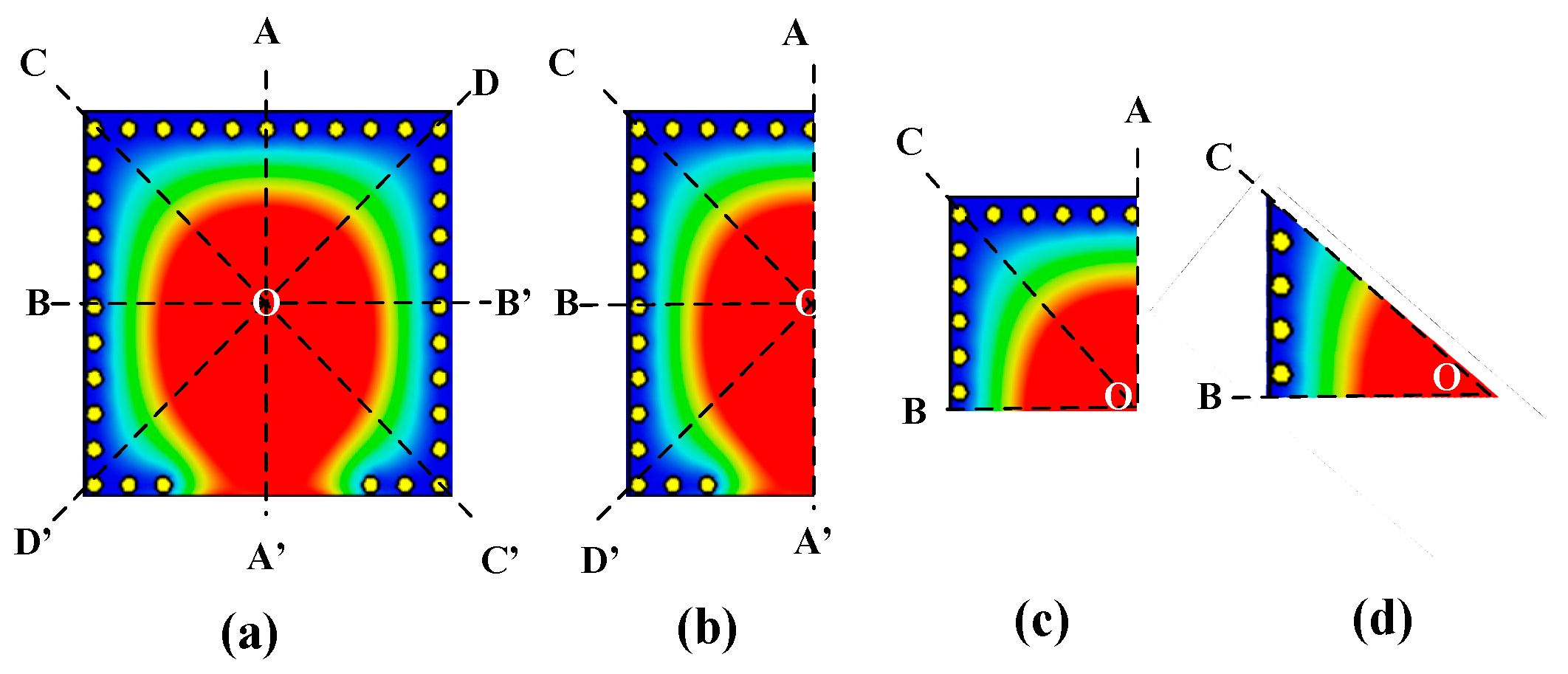

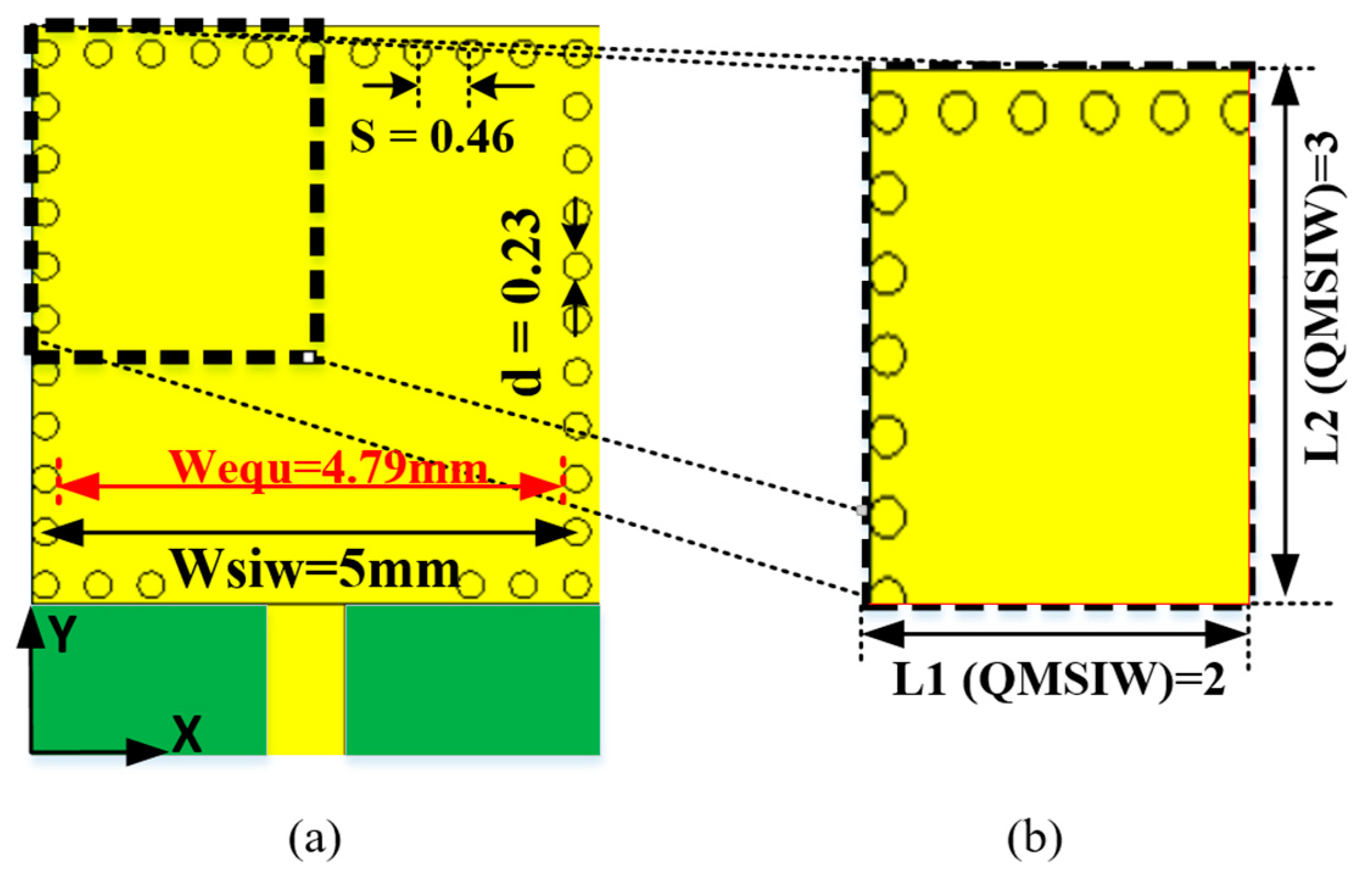
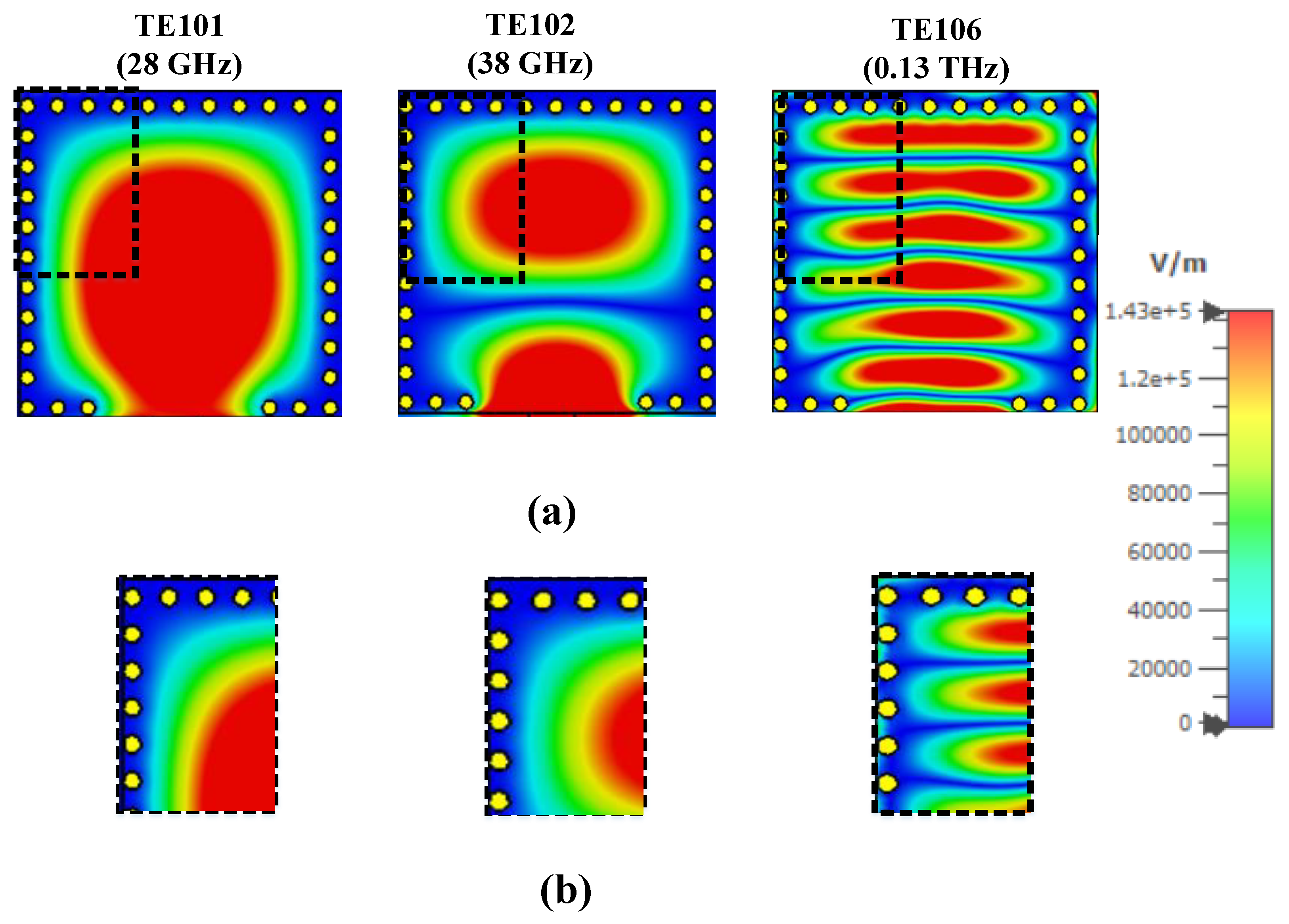


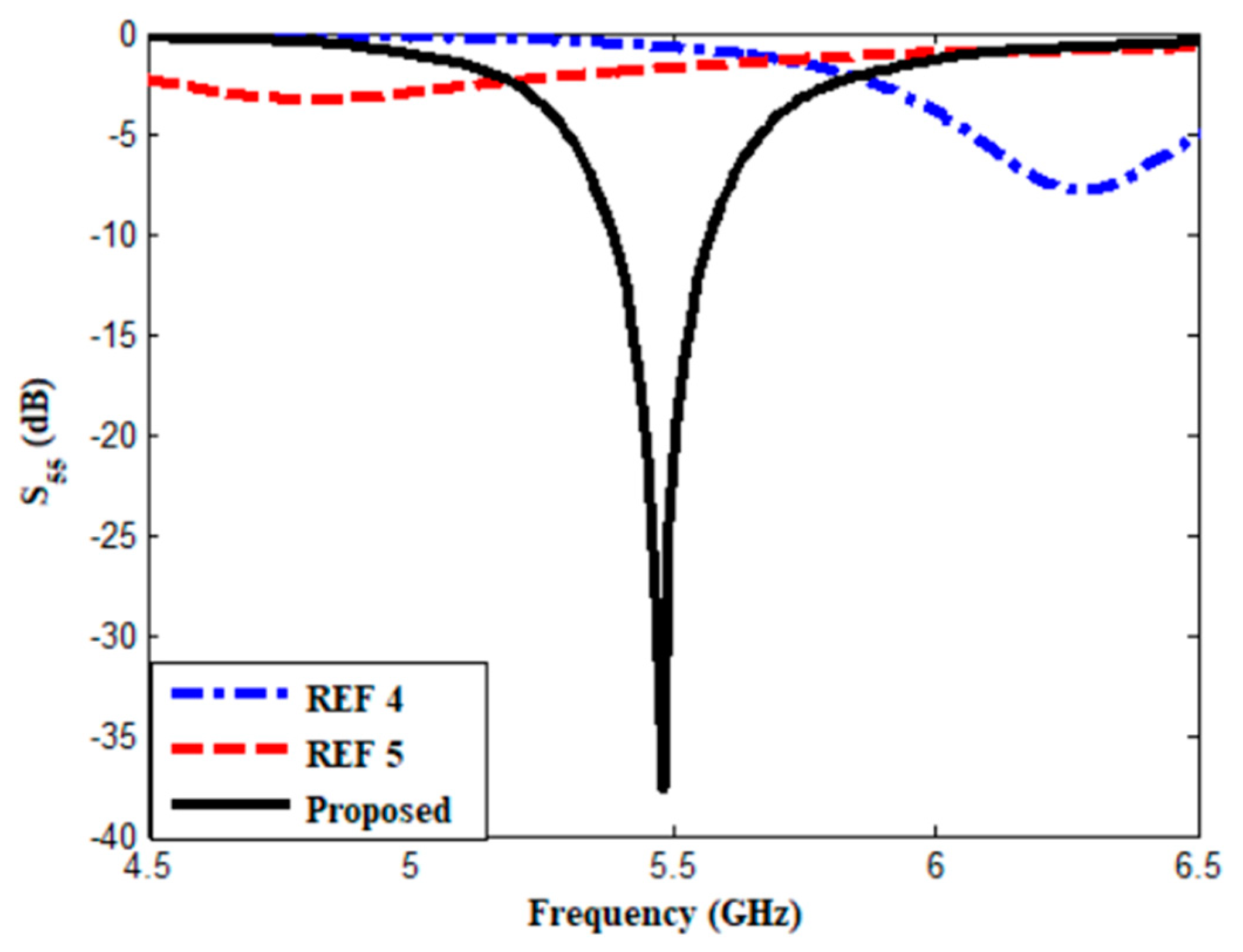

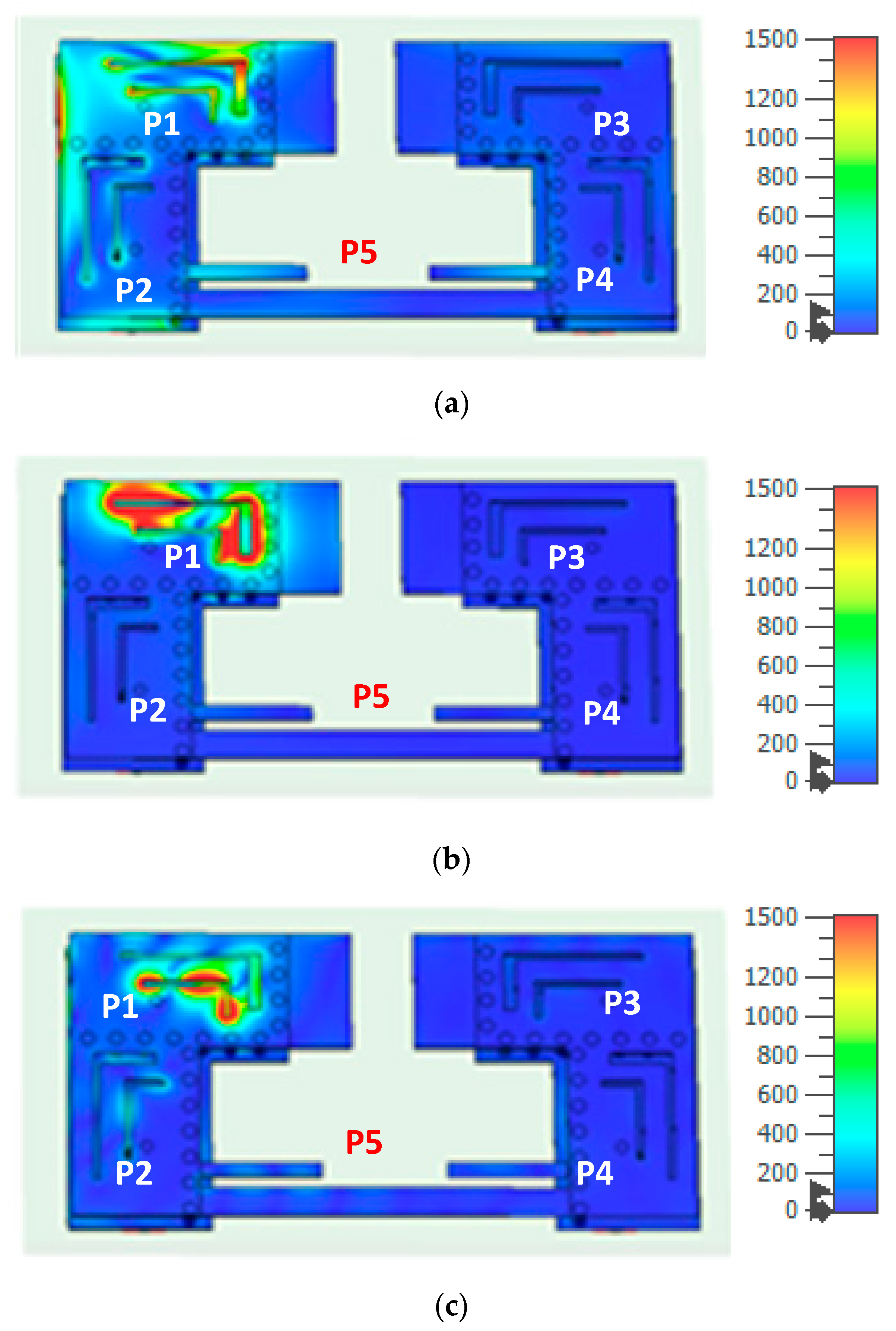

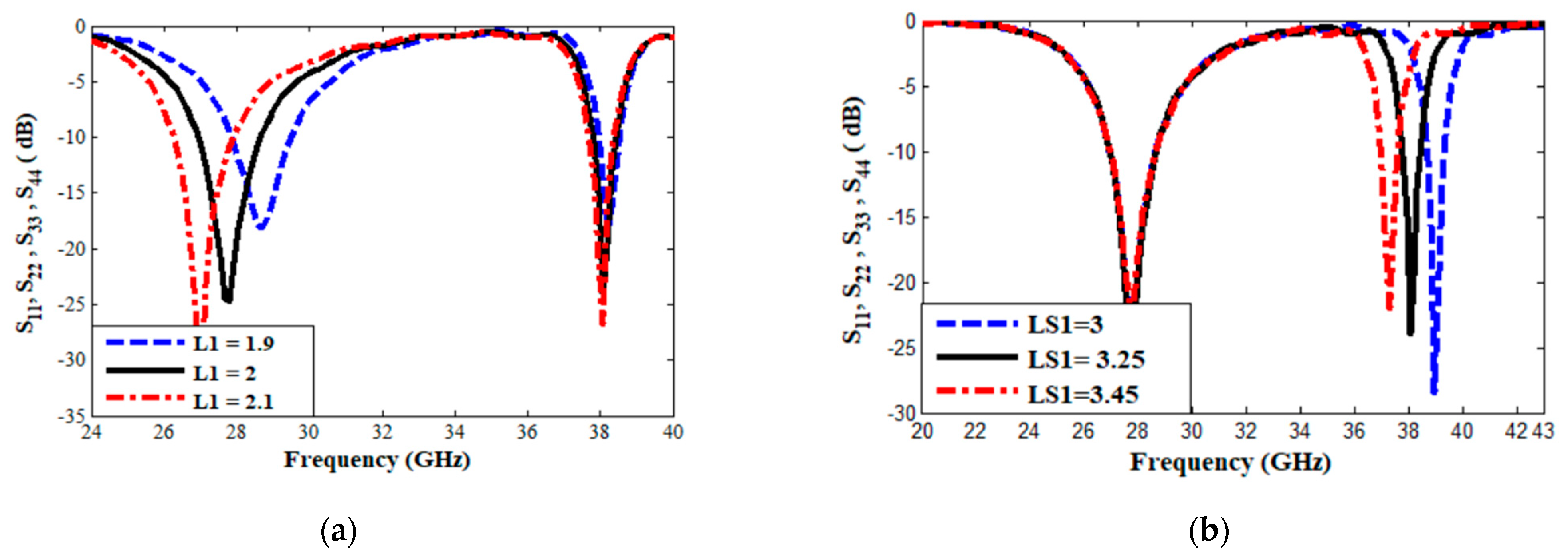
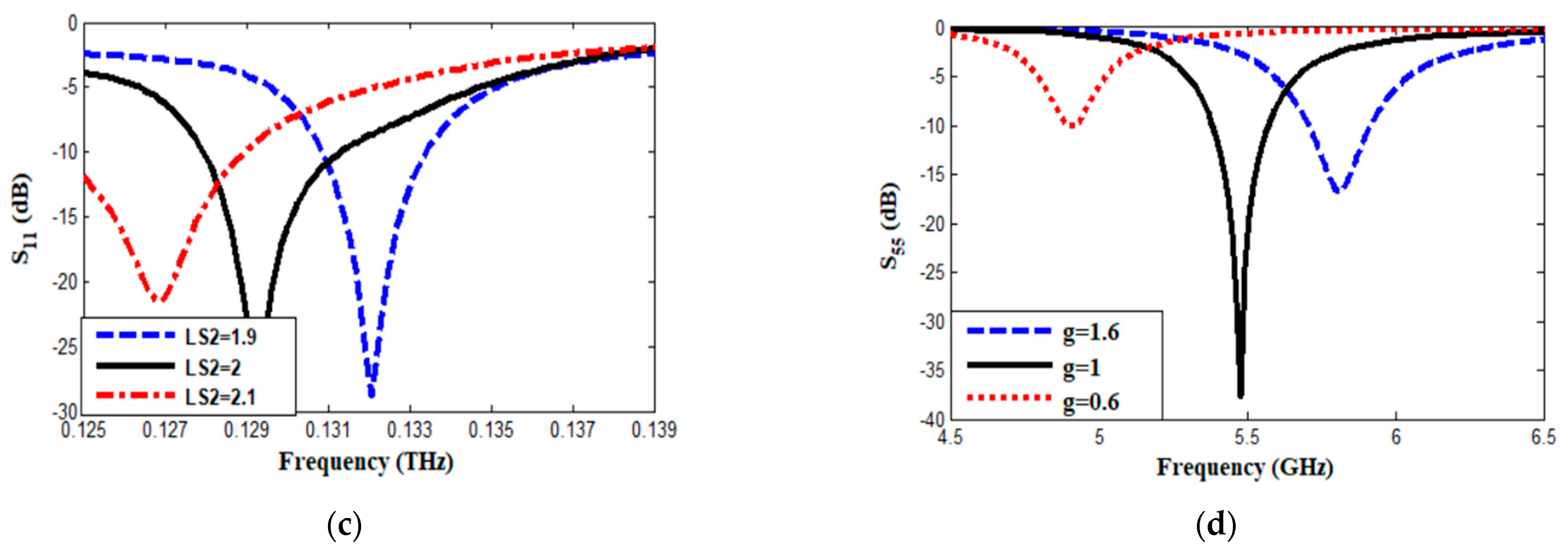
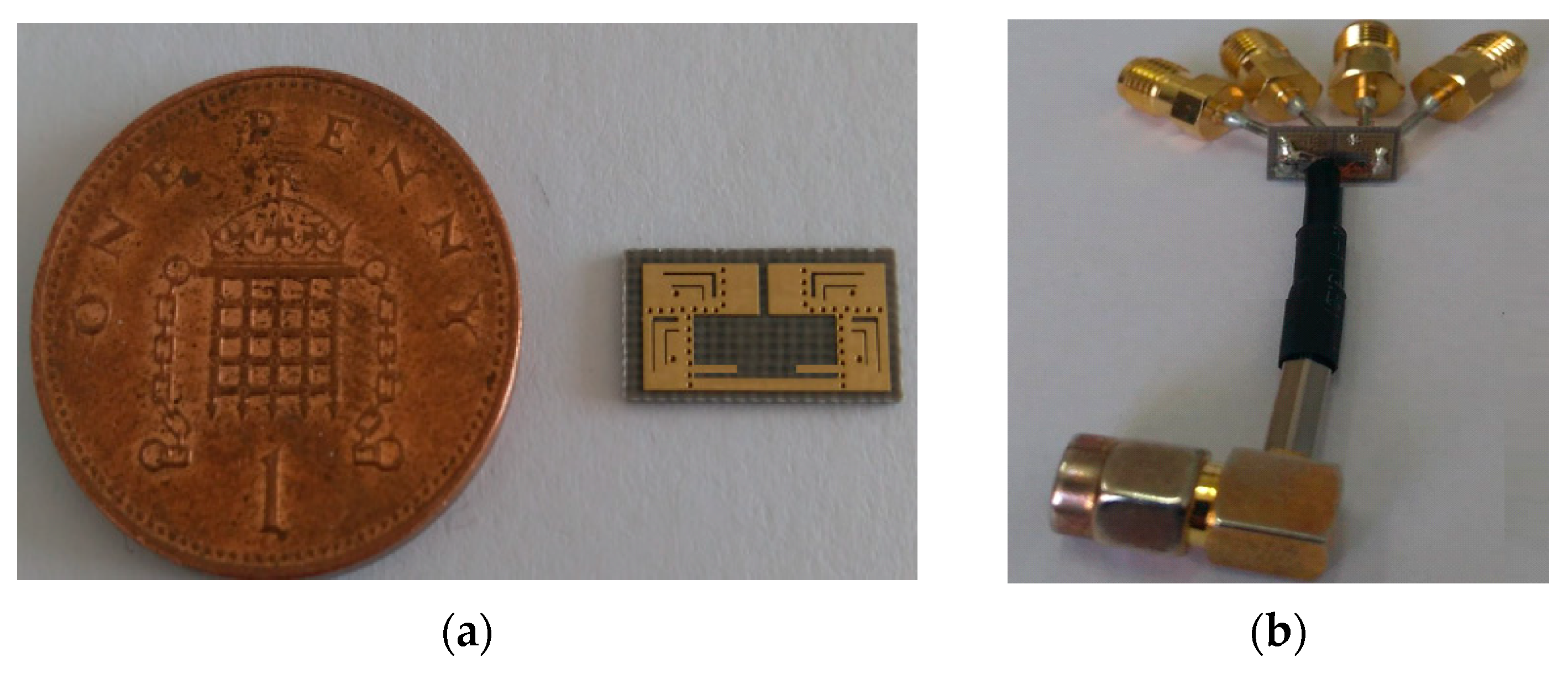
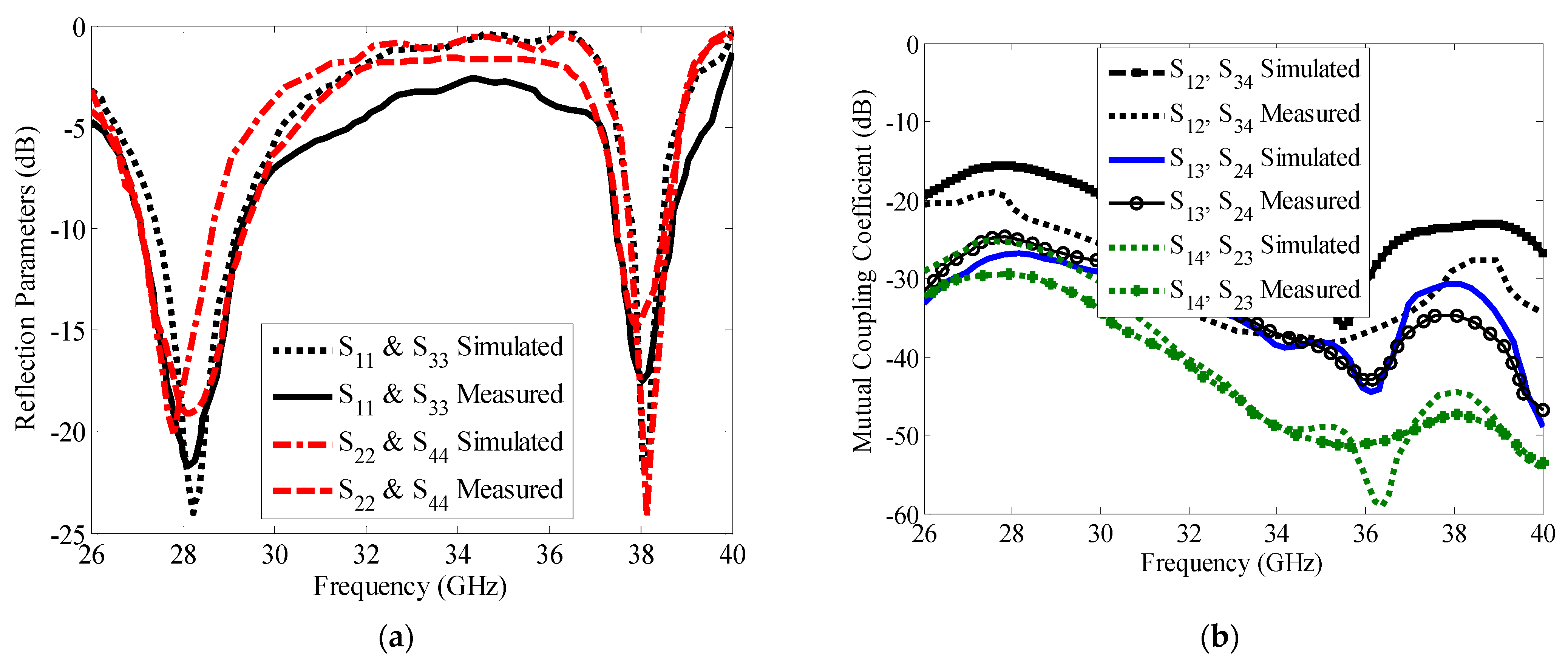

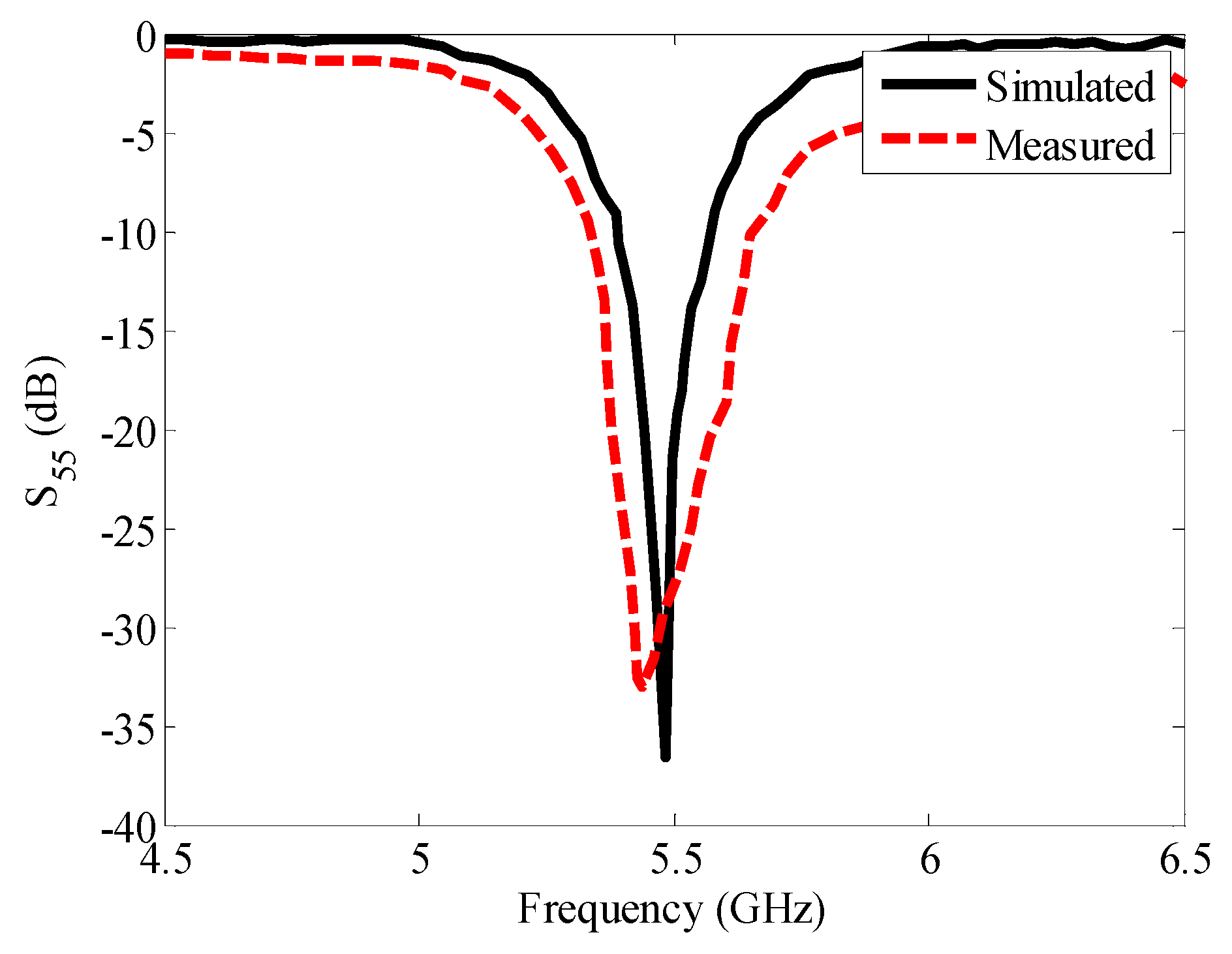
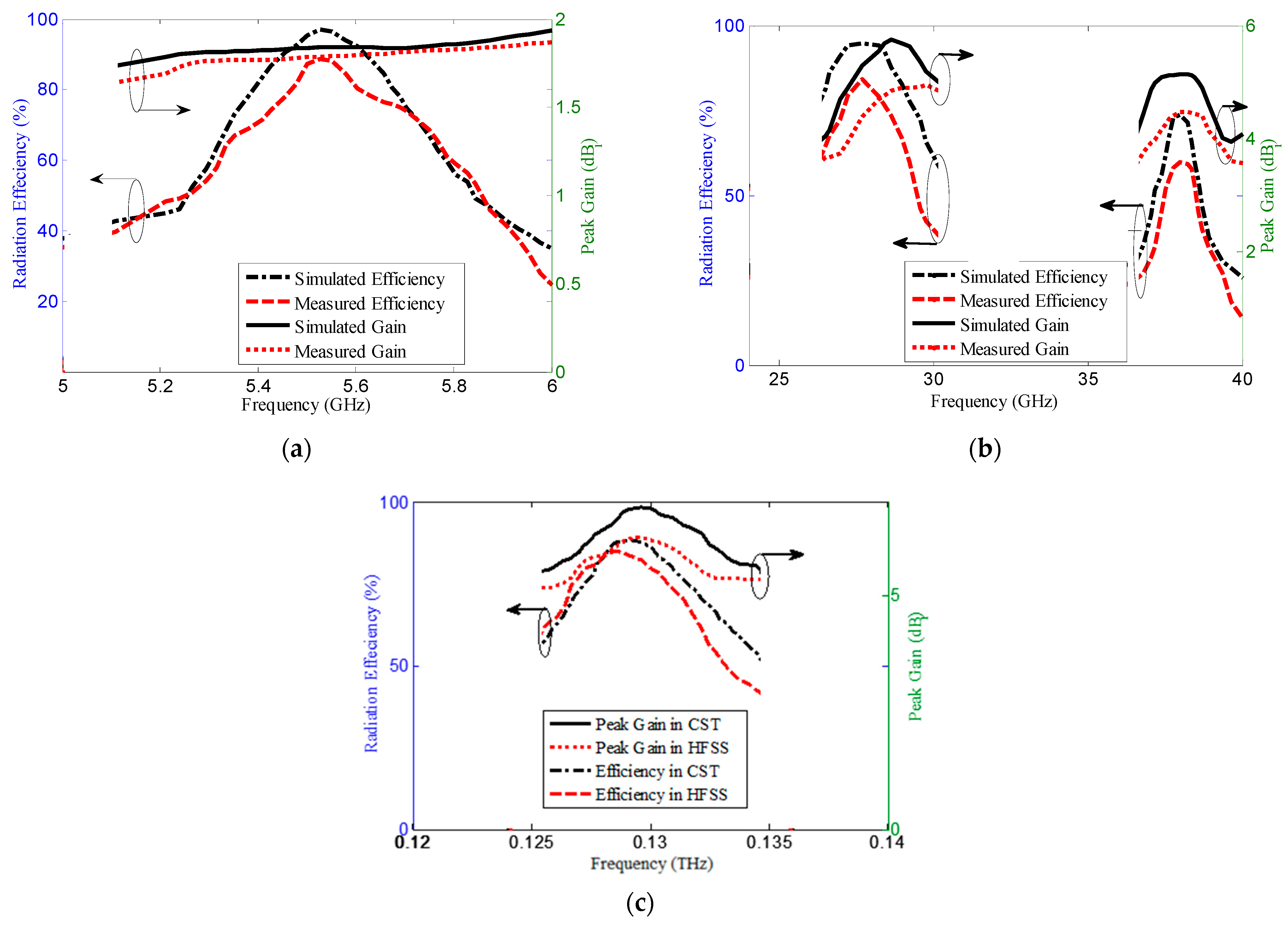

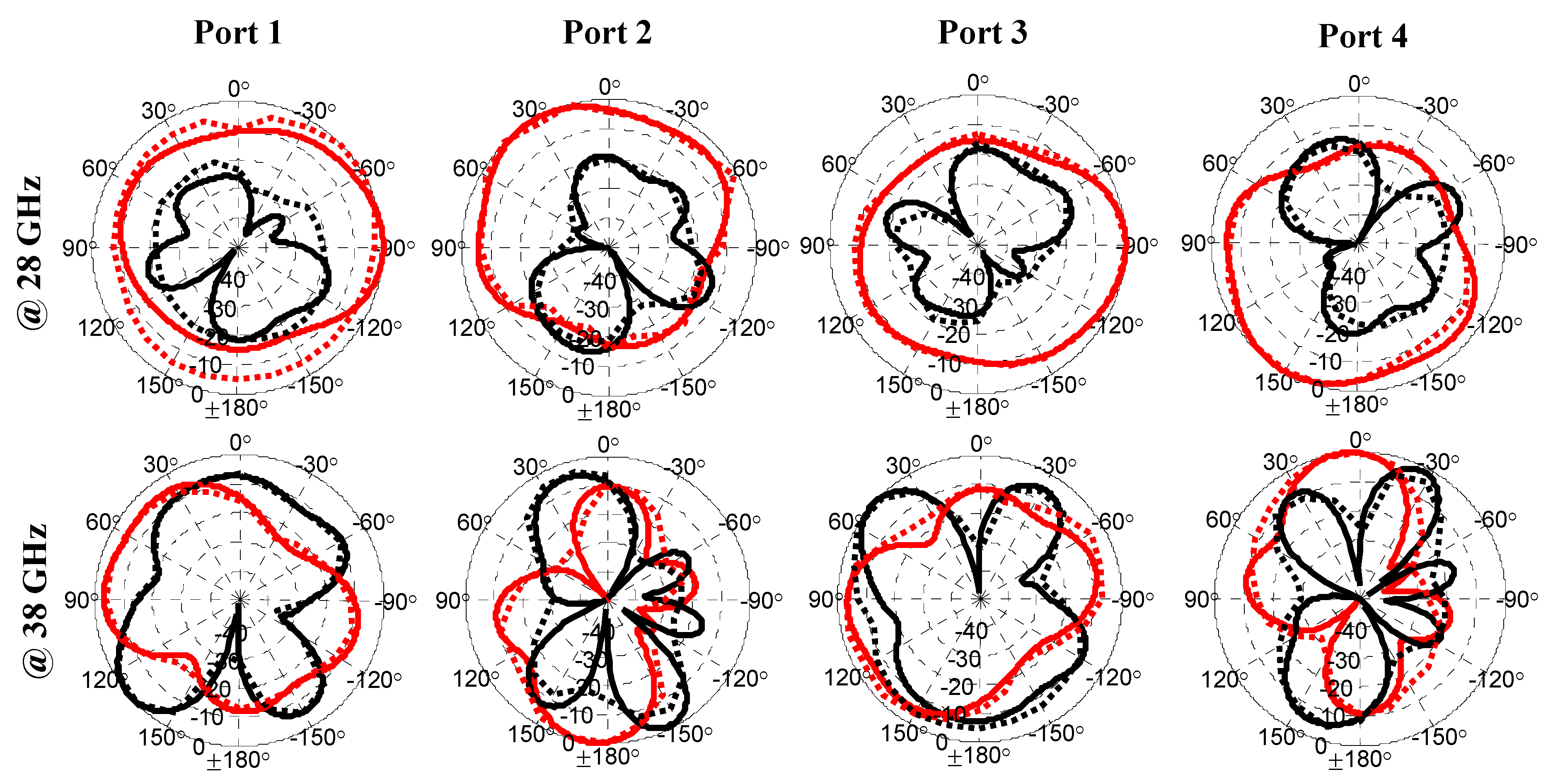
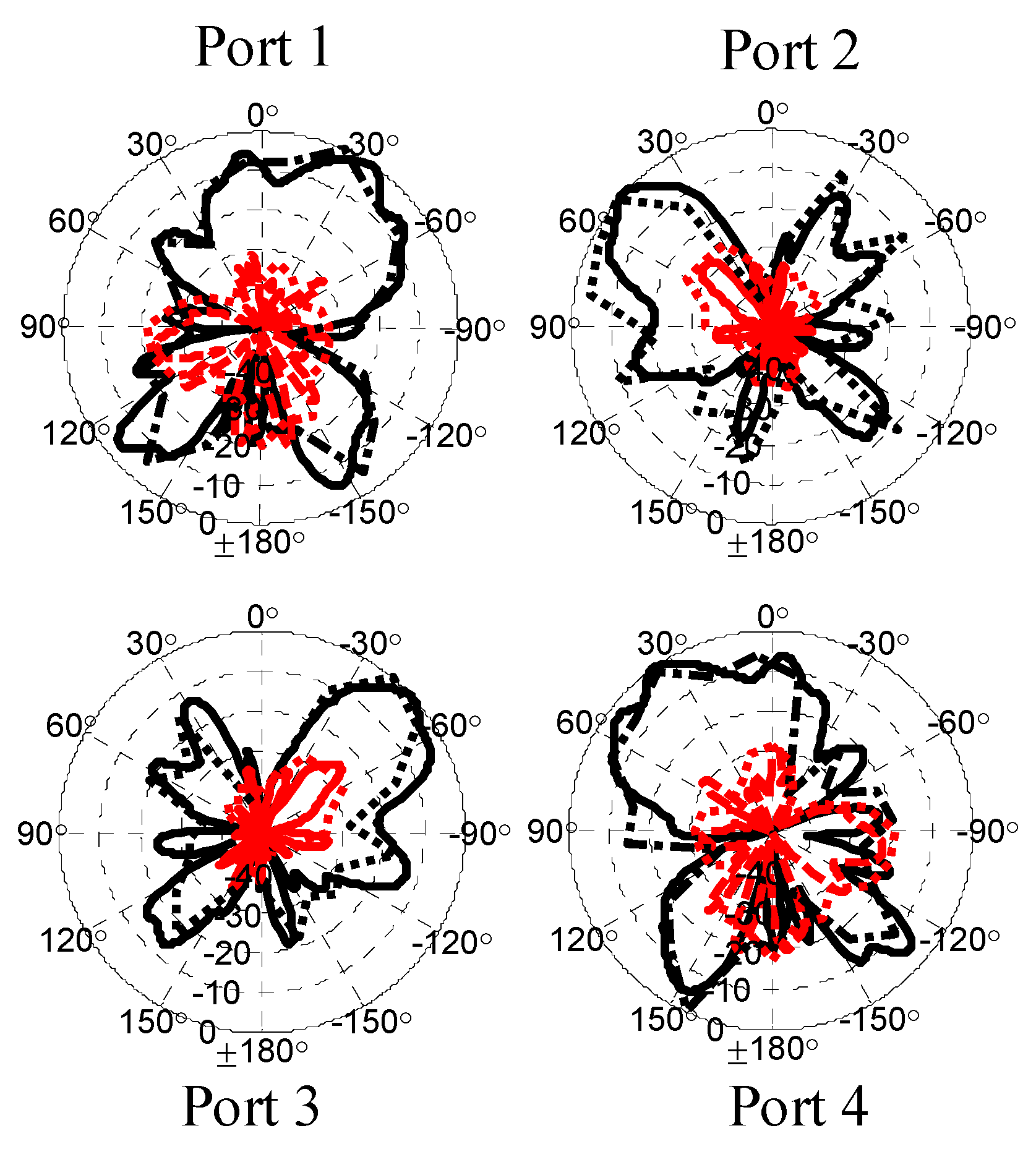
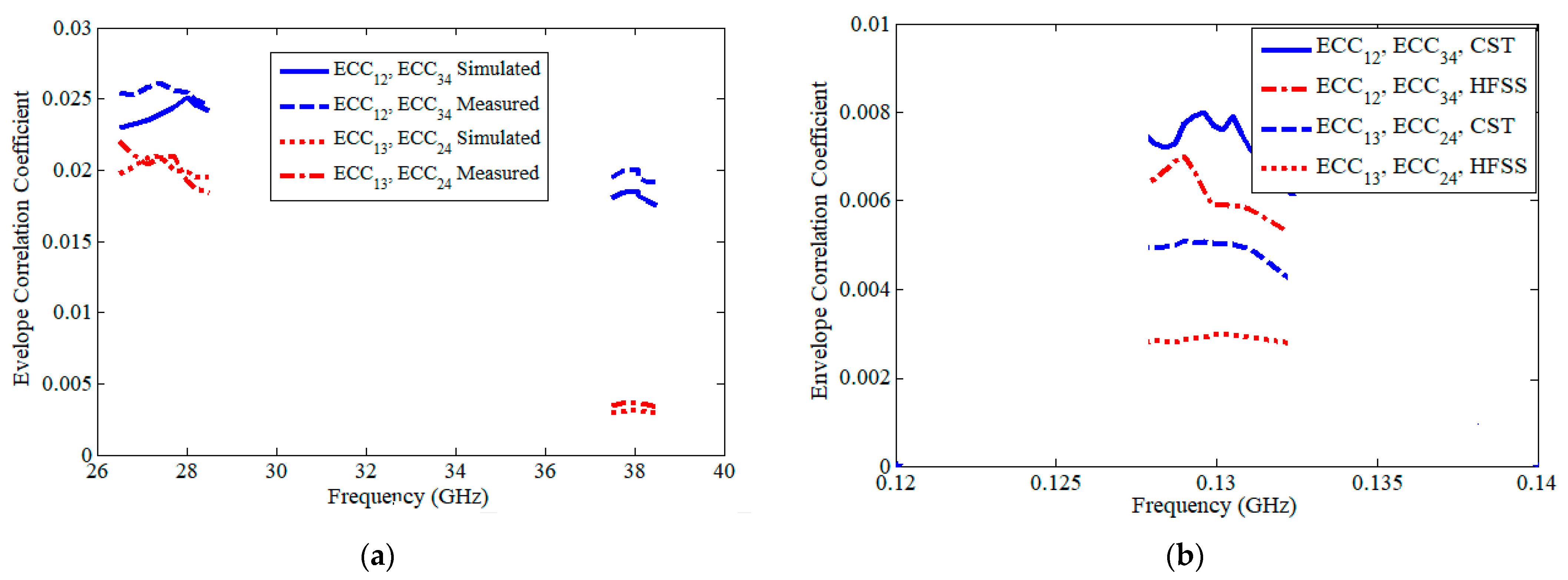
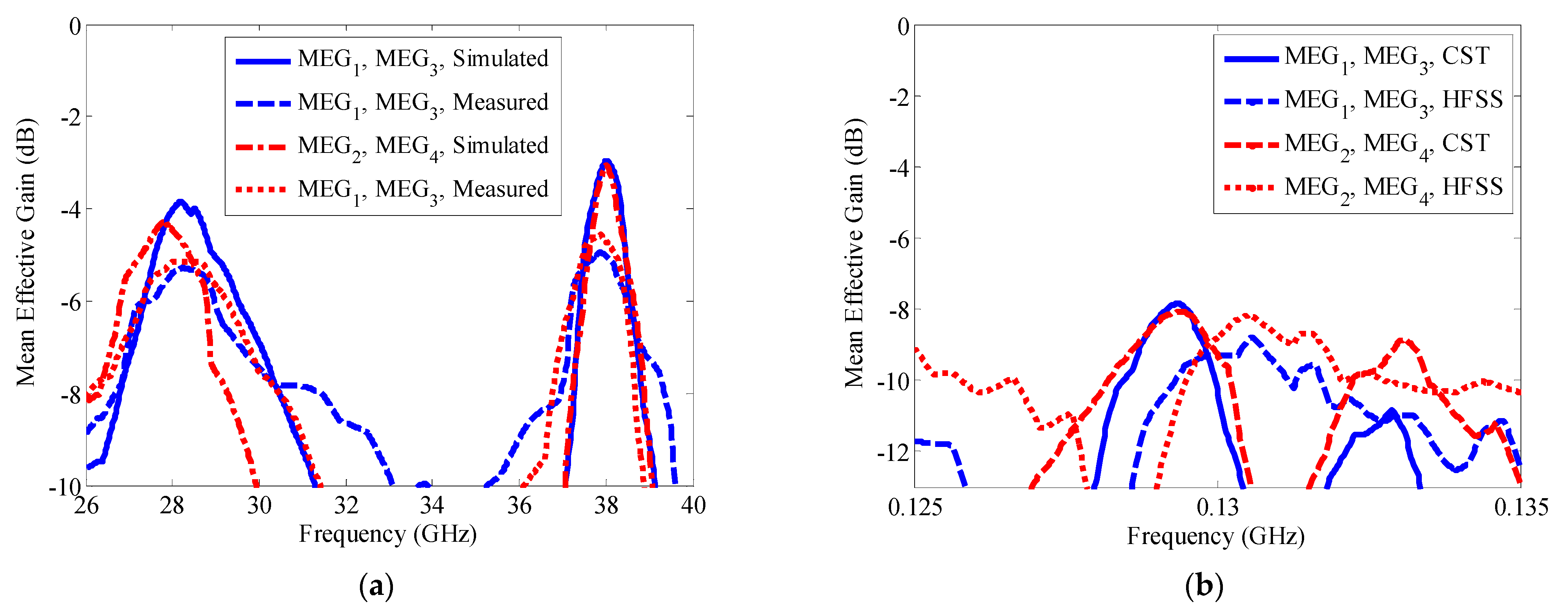
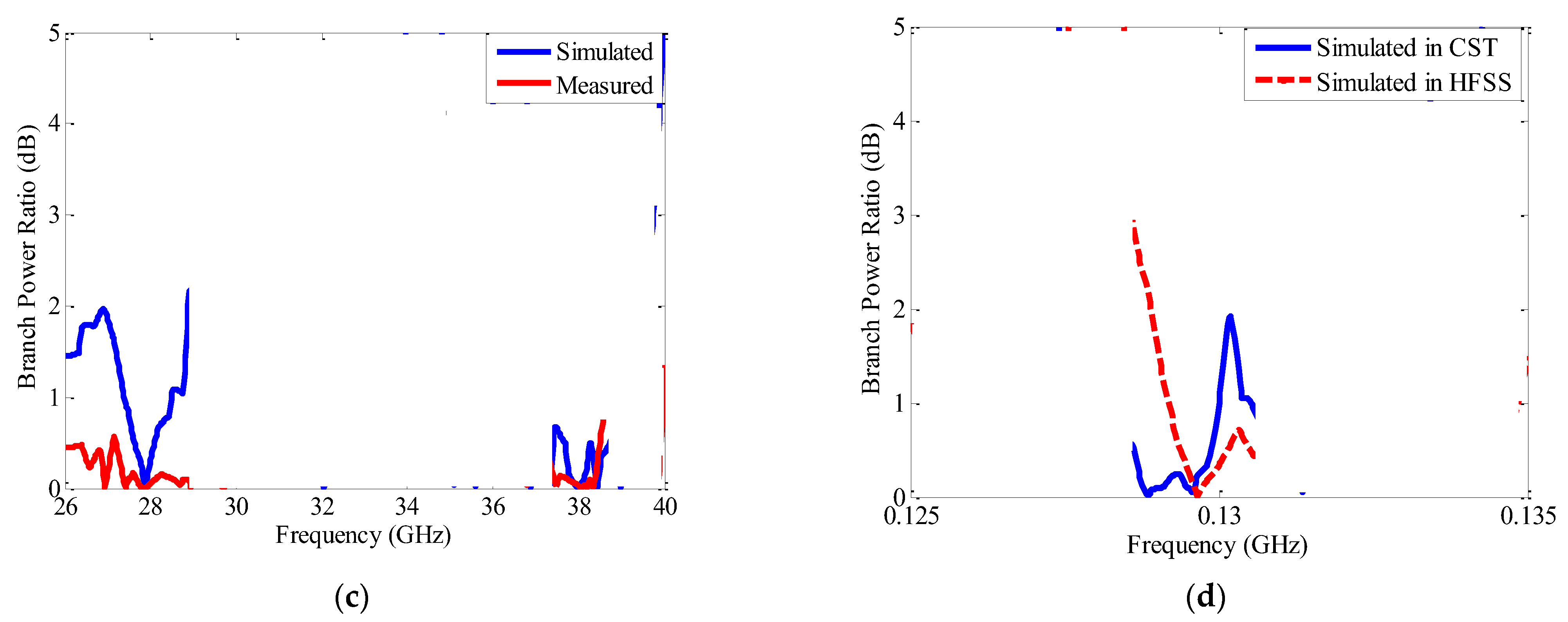
Disclaimer/Publisher’s Note: The statements, opinions and data contained in all publications are solely those of the individual author(s) and contributor(s) and not of MDPI and/or the editor(s). MDPI and/or the editor(s) disclaim responsibility for any injury to people or property resulting from any ideas, methods, instructions or products referred to in the content. |
© 2023 by the authors. Licensee MDPI, Basel, Switzerland. This article is an open access article distributed under the terms and conditions of the Creative Commons Attribution (CC BY) license (https://creativecommons.org/licenses/by/4.0/).
Share and Cite
Altakhaineh, A.T.; Alja’afreh, S.S.; Almatarneh, A.M.; Almajali, E.; Al-Tarawneh, L.; Yousaf, J. A Quad-Band Shared-Aperture Antenna Based on Dual-Mode Composite Quarter-Mode SIW Cavity for 5G and 6G with MIMO Capability. Electronics 2023, 12, 2480. https://doi.org/10.3390/electronics12112480
Altakhaineh AT, Alja’afreh SS, Almatarneh AM, Almajali E, Al-Tarawneh L, Yousaf J. A Quad-Band Shared-Aperture Antenna Based on Dual-Mode Composite Quarter-Mode SIW Cavity for 5G and 6G with MIMO Capability. Electronics. 2023; 12(11):2480. https://doi.org/10.3390/electronics12112480
Chicago/Turabian StyleAltakhaineh, Amjaad T., Saqer S. Alja’afreh, Aser M. Almatarneh, Eqab Almajali, Luae Al-Tarawneh, and Jawad Yousaf. 2023. "A Quad-Band Shared-Aperture Antenna Based on Dual-Mode Composite Quarter-Mode SIW Cavity for 5G and 6G with MIMO Capability" Electronics 12, no. 11: 2480. https://doi.org/10.3390/electronics12112480





